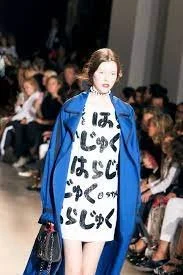The Japanese Writing Systems - A Brief Introduction
If you were to ask any anime fan the simple question of whether their countless hours spent watching the iconic films ever amounted to their cumulation of the Japanese language, you’d be sure to receive a response somewhere along the lines of “yeah, somewhat.” I was never an avid anime fan, and therefore my Japanese knowledge was rather scant. But recently, I have taken an interest in the Japanese language, and thus explored that interest by spending some time on Duolingo. An hour later, I emerged with a few words of vocabulary stored in my belt, thinking to myself, “This language can’t be too hard to learn!” However, some light research proved me wrong. Not only were there three different alphabets, but each alphabet had its own uses in different areas. Let's delve into the main differences betweens the alphabets.
Katakana
This alphabet is often regarded as the most evolved of all Japanese and has a wide range of uses, which include but are not limited to manga and fashion. Known for their sharper and more defined look, the characters achieved widespread use and are frequently portrayed on clothing and even on billboards across Japan. Well-known brands such as Adidas and Nike have hopped on the trend with their creations decorated with Katakana characters (Katakana is cool).It is the most rapidly growing area of the Japanese language, which is not surprising given its diverse areas of usage (MIT Press). Katakana is known to contain gairaigo, or words with Chinese, Dutch or French origins. Most notoriously known are wasei-eigo, English-sounding words with Japanese meanings (Tofugo). To non-native speakers, this branch may be particularly difficult due to in part the lack of relation between how the words sound and how they actually function, but also because of its constant rapid evolution, which leads to words being recycled faster than they can be learned.
Hiragana
Often seen as the more feminine counterpart of Katakana due to its soft and rounded appearance, Hiragana represents the backbone of Japanese for many (Katana is cool). Perhaps its more feminine appearance stems from the fact that it was created by the limited number of upper-class females who could read Kanji (The Tech). It is believed that learning Hiragana is the first step towards learning Japanese, as it serves as a building block for further learning of the language. Given its reduced complexity in comparison to Katakana and its mainstream nature, this alphabet is typically what those who wish to learn the language first start with (Tokyo Weekender).
Kanji
Spanning over 50,000 characters, it is safe to say that kanji is perhaps the most memory-intensive alphabet of the three. However, having around 1,000 characters memorized in your back pocket would be enough to get you through the majority of Japanese-written works (Busuu). The idea behind Kanji is that they merely denote symbols with meanings and are aided by Hiragana and Katakana to pronounce. Initially reserved for upper-class Japanese men, Kanji prompted the creation of Hiragana, an alphabet (as mentioned above) developed specifically for women, by women (The Tech). Thankfully, such ideas are not as widespread now as they were before, and as a result, Kanji is used by the vast majority of Japan.
Sources Consulted
Allen, Jay. “Group Promoting Latin Characters for Japanese Writing Gives Up.” Unseen Japan, 30 May 2023, unseen-japan.com/romaji-japanese-group-folds/. Accessed 30 June 2024.
“Katakana Is Cool: Designers Take Inspiration from Japan’s Least Popular Writing System.” SoraNews24 -Japan News-, 19 Nov. 2014, soranews24.com/2014/11/20/katakana-is-cool-designers-take-inspiration-from-japans-lea st-popular-writing-system/.
Moor, Lisandra. “Learning Japanese: Is Katakana More Difficult to Use than Kanji?” Tokyo Weekender, 17 Mar. 2020, www.tokyoweekender.com/art_and_culture/japanese-culture/learning-japanese-is-kataka na-more-difficult-to-use-than-kanji/. Accessed 30 June 2024.
“Japanese Alphabet: The 3 Writing Systems Explained.” Busuu, www.busuu.com/en/japanese/alphabet#:~:text=These%20three%20systems%20are%20called.
Reader, The MIT Press. “Tokyoids: The Aesthetics of Dismemberment in Japan.” The MIT Press Reader, 23 Mar. 2023, thereader.mitpress.mit.edu/tokyoids-the-aesthetics-of-dismemberment-in-japan/. Accessed 30 June 2024.
Bernard, Chelsea. “Wasei Eigo.” Tofugu, 27 Oct. 2014, www.tofugu.com/japanese/wasei-eigo/.
Chandler, Alana. “When the Japanese Language Is No Longer “Kawaii.”” The Tech, thetech.com/2020/03/12/kanji-sexism.
Images
Adidas Originals. 18 Nov. 2014, www.fashion-press.net/news/gallery/13871/240699. Accessed 7 July 2024.


